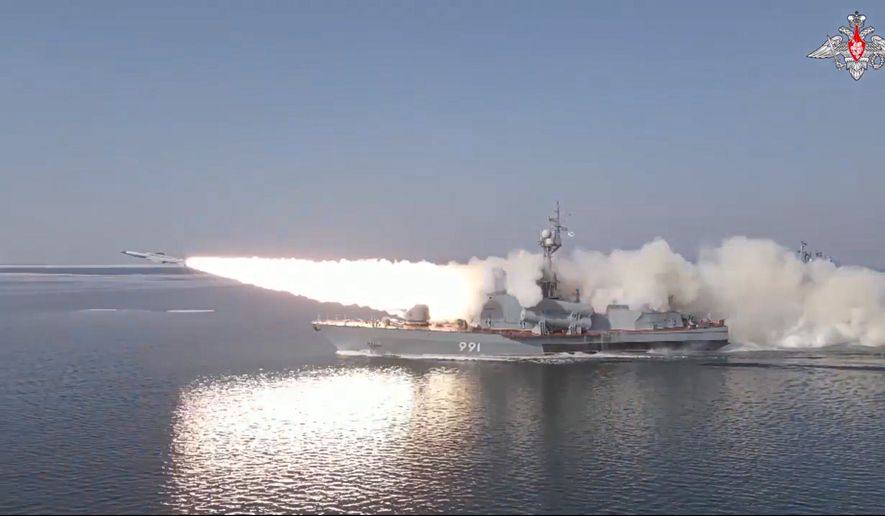SEOUL, South Korea — Russia test-fired two anti-ship missiles into the Sea of Japan on Tuesday, days after the Japanese prime minister visited Ukraine and the same day that a U.S. aircraft carrier docked in South Korea as part of joint training drills.
Two Russian fast-missile boats fired two projectiles at mock targets 62 miles away during drills in the Peter the Great Gulf, south of Vladivostok in the Sea of Japan, the Kremlin announced. According to The Moscow Times, the missiles were “Moskit” (“Mosquito”) cruise missiles, which can travel at three times the speed of sound and have a range of more than 100 miles.
The missile tests follow the flight of two nuclear-capable Russian TU-95 “Bear” strategic bombers over the Sea of Japan last week, further raising tensions in the region.
Ties between Moscow and Tokyo have been stressed by territorial disputes in the Sea of Japan dating to the end of World War II, and Japan has taken an unexpectedly active role in the NATO-led coalition opposing Russia’s invasion of Ukraine and rallying international opposition to the Kremlin.
Prime Minister Fumio Kishida told Japanese media that Japan will “keep monitoring the moves by the Russian military.” Foreign Minister Yoshimasa Hayashi said that, in addition to operations in Ukraine, Russian units are “intensifying their activities also in the Far East.”
The U.S.-South Korean military exercises have infuriated North Korea, and it was not known whether the Russian missile tests were timed to coincide with the drills. The Biden administration has accused Pyongyang of aiding the Russian war effort by supplying artillery shells to replenish depleted Russian arsenals in Ukraine.
SEE ALSO: U.K. officials: Russia taking heavy losses with minor gains in latest Donetsk fighting
Meanwhile, the biggest South Korean-U.S. drills since 2017 are underway on, over and off the peninsula, infuriating North Korea.
Pyongyang last week said it had tested a Russian-style, nuclear-capable underwater drone, and on Tuesday unveiled what it said were tactical nuclear warheads.
Also on Tuesday, the USS Nimitz aircraft carrier made a port call to South Korea’s Busan. Amphibious landing drills involving American, British and Korean marines are set to hit beaches on South Korea’s east coast Wednesday.
Whether the Russian missile tests, which have won widespread coverage, were timed to coincide with these acts is unknown, but they follow humiliating failures and bloody setbacks for Russian naval and marine forces in Ukraine.
Russia’s foundering fleet
At a time when Moscow’s battered military is struggling with weapons supplies in Ukraine — to the point where it is removing tanks designed in the 1960s from mothballs and upgrading them for frontline service — the assets deployed in Pacific waters are hardly top-tier. “Bear” bombers date back to 1952, while “Moskit” missiles entered service in 1984.
SEE ALSO: North Korea’s released photos point to its progress on ‘tactical’ nuclear weapons
Russia’s Pacific Fleet fields two brigades of naval infantry, and both units have been sent west to the Ukrainian front.
The Vladivostok-based 155th Brigade has been decimated in a series of failed assaults on the town of Vuhledar, and the 40th Brigade, based in Kamchatka, was battered in earlier fighting.
Russia’s Black Sea Fleet retreated from the Ukrainian coastline after the April sinking of its flagship, the cruiser Moskva. In June, Snake Island — an outpost that extends Ukraine’s reach 22 miles beyond its coast — was recaptured by Ukrainian forces after it was seized by Russia in an iconic early action of the war.
Russia, a transcontinental power, does not have a reputation for naval excellence.
Its Pacific Fleet was defeated by Japanese forces in the 1904-1905 Russo-Japanese War, necessitating reinforcements from Russia’s Baltic Fleet. After a grueling voyage, that fleet was shattered by Japan in the Tsushima Strait — the first time an Asia power had defeated a European power in the industrial age.
In World War II, Moscow’s Pacific Fleet assumed a significant role only in the final three weeks of the conflict, supporting shock Soviet attacks into Manchuria and Korea while seizing South Sakhalin and the Kuril Islands from Tokyo. Japan to this day is seeking the return of the Kurils.
• Andrew Salmon can be reached at asalmon@washingtontimes.com.




Please read our comment policy before commenting.